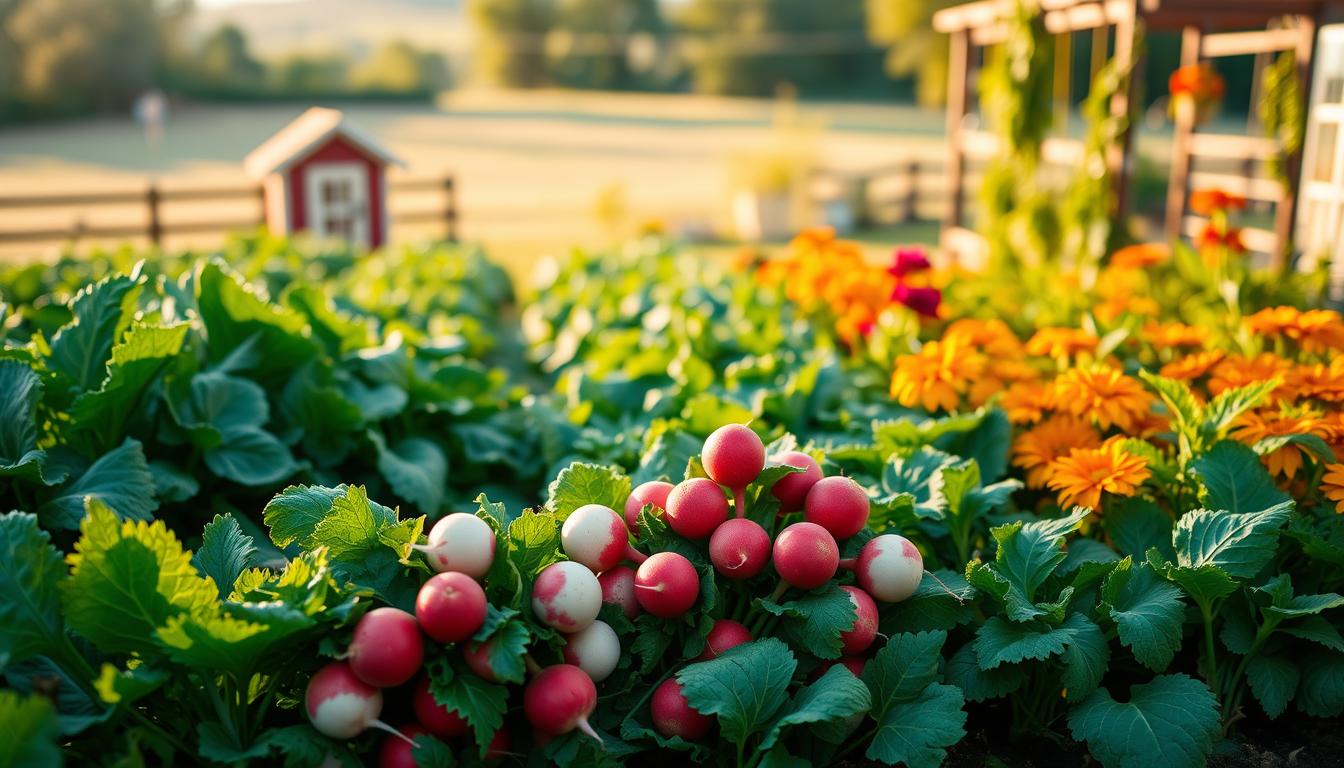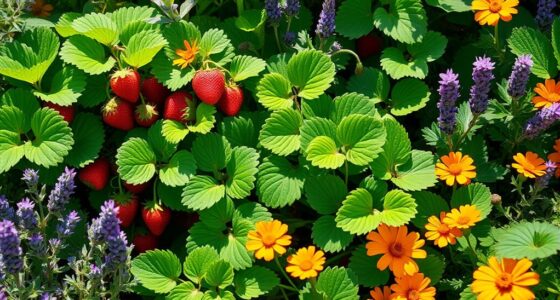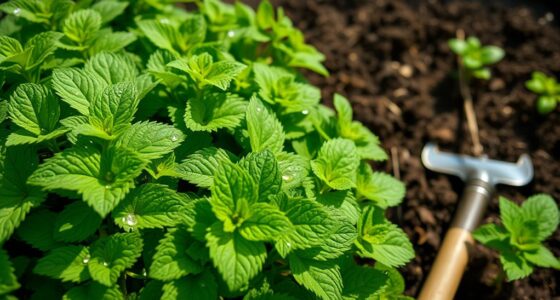When you step into your garden, there’s something undeniably gratifying about seeing a landscape of flourishing plants. Each sprout carries the promise of nourishment, not only for you, but for the ecosystem around you. As you dive into your gardening journey, consider welcoming radish companion plants into your space. This radish companion planting guide will be your go-to resource for pairing radishes with the best companion plants, so you can cultivate a thriving and sustainable garden. Imagine the joy of harvesting vibrant radishes alongside hardy greens and aromatic herbs, transforming your meals and garden into a celebration of nature’s bounty.
Key Takeaways
- Understanding the role of radish companion plants can enhance growth and health.
- Companion planting optimizes your garden space effectively.
- Investing in the right companions for your radishes can yield better harvests.
- Learn about different plant pairings to maximize your gardening experience.
- Enhancing biodiversity in your garden helps create a balanced ecosystem.
Understanding Radishes and Their Growth Needs
Radishes are delightful members of the Brassicaceae family, known for their rapid growth and distinctive flavor. The understanding of radish growth needs is essential for any gardener looking to incorporate this vibrant vegetable into their plot. With the right conditions, you can cultivate radishes that not only thrive but also offer a host of nutritional benefits.
What Are Radishes?
Radishes are root vegetables celebrated for their sharp, peppery taste. They typically grow in various colors, including red, white, and purple, making them a colorful addition to your garden. These vegetables flourish in cooler temperatures and are commonly planted in spring or fall, making them versatile for different seasons.
Nutritional Benefits of Radishes
Incorporating radishes into your diet offers an array of nutritional benefits. These crunchy veggies are packed with vitamin C, potassium, and fiber, all contributing to a healthy lifestyle. Their low-calorie count and high water content make them an excellent choice for weight management. Eating radishes can boost your immune system and improve digestion.
Ideal Growing Conditions for Radishes
Successful radish cultivation requires specific growing conditions. Aim for temperatures between 50 and 65 degrees Fahrenheit, as these conditions foster optimal growth. Radishes thrive in well-draining soil that offers consistent moisture, but be cautious with nitrogen levels. Heavy nitrogen fertilization can lead to lush foliage at the expense of strong, flavorful roots. Providing at least six hours of sunlight daily is crucial for healthy radish development. Choosing suitable radish planting partners such as leafy greens or legumes can enhance growth and yield.
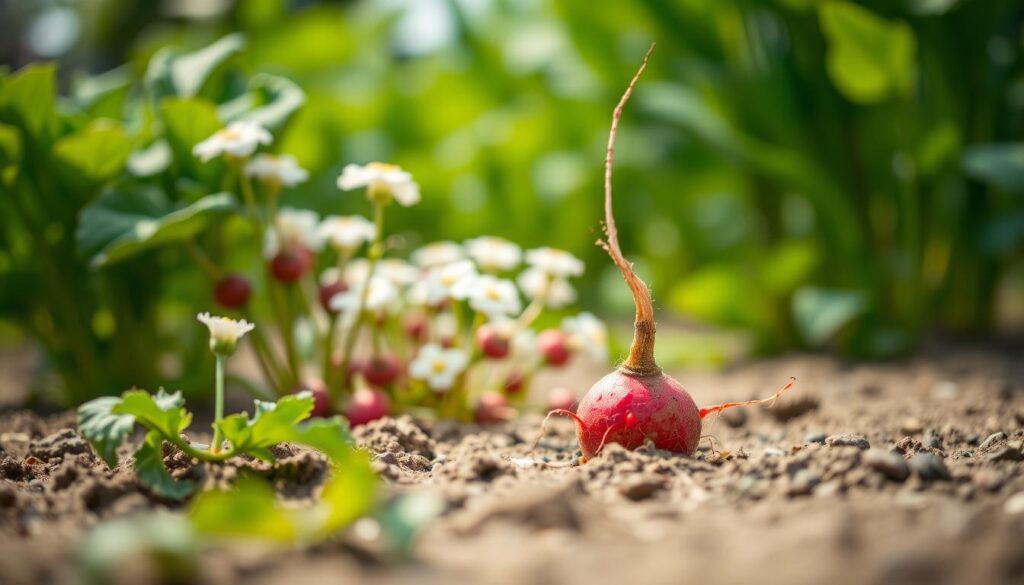
| Growing Condition | Details |
|---|---|
| Optimal Temperature | 50-65°F |
| Sunlight | 6 hours daily |
| Soil Type | Well-draining, consistent moisture |
| Nitrogen Needs | Avoid heavy fertilization |
The Importance of Companion Planting
Companion planting indicates a gardening practice where different crops are grown together to promote growth and discourage pests. This method not only enhances the health of plants but also optimizes the available gardening space. For radish growers, understanding the benefits of companion planting is vital. Utilizing a radish companion planting chart can simplify the selection of optimal neighboring plants.
What Is Companion Planting?
Companion planting involves strategically placing different plants in close proximity. This can lead to improved growth, reduced pests, and increased yield. Various combinations can provide synergies that benefit the entire garden ecosystem. Some plants can attract beneficial insects or improve soil conditions, creating a vibrant environment.
Benefits of Growing Radishes with Other Plants
Growing radishes alongside certain plants can yield significant benefits. They can act as trap crops, drawing pests away from more vulnerable plants. Additionally, radishes help in soil aeration, aiding the growth of neighboring roots. The combination of these factors leads to healthier plants and a more fruitful garden. Understanding the benefits of companion planting allows you to make informed decisions that enhance your gardening success.
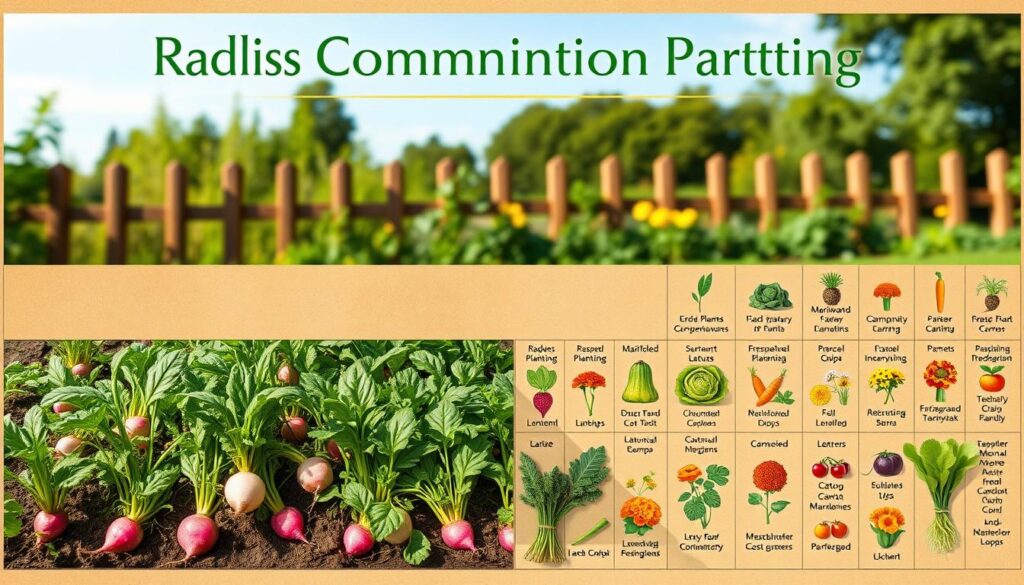
Best Companion Plants for Radishes
Choosing the best companion plants for radishes can significantly enhance your garden’s productivity and health. By selecting compatible plants, you can optimize the growing conditions for your radishes while also benefiting neighboring plants. Here’s a look at some of the top choices.
Leafy Greens
Leafy greens, like lettuce and spinach, make excellent companions for radishes. These plants thrive in similar growing conditions, sharing nutrients while minimizing competition for sunlight. When planted together, they can create a lush, dense garden that is both visually appealing and productive.
Legumes
Legumes such as beans and peas are wonderful partners for radishes. They enrich the soil by fixing nitrogen, which is crucial for healthy radish growth. Additionally, their foliage provides shade, helping to maintain optimal soil moisture for the radishes underneath.
Herbs and Aromatics
Radish companion herbs include chervil, while garlic and onions serve as potent aromatics. These plants offer pest-repelling qualities that can enhance radish health. Planting these radish companion herbs not only protects your garden but also encourages biodiversity, making your gardening experience more rewarding.
Flowers that Attract Beneficial Insects
Consider planting flowers such as calendula and marigolds alongside your radishes. These radish companion flowers attract beneficial insects, such as ladybugs and lacewings, that help control harmful pests. By creating a vibrant ecosystem, you ensure that your garden remains healthy and productive.
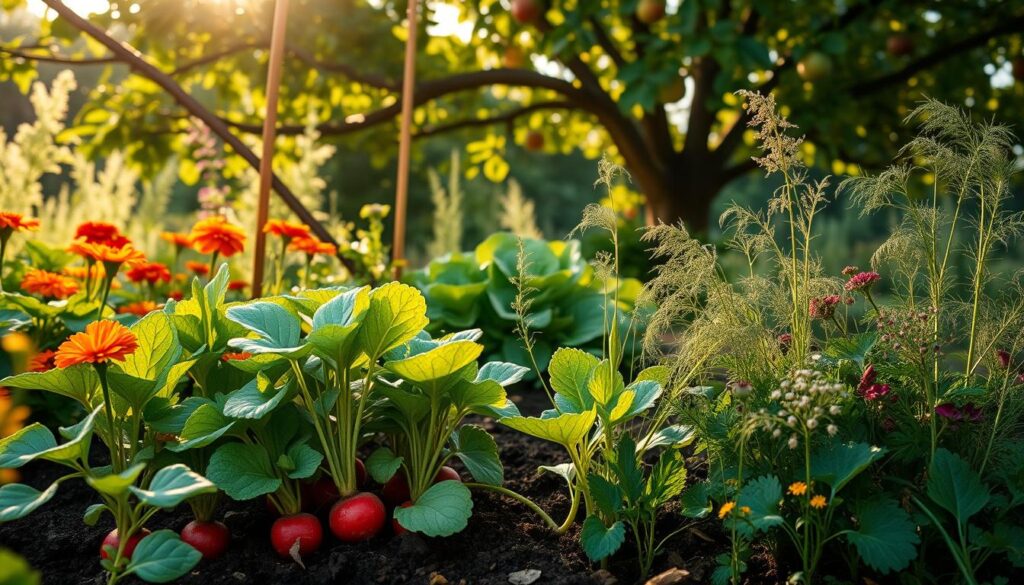
| Companion Plant Type | Benefits |
|---|---|
| Leafy Greens | Share nutrients, minimal sunlight competition |
| Legumes | Fix nitrogen in soil, provide shade |
| Herbs and Aromatics | Repel pests, encourage biodiversity |
| Flowers | Attract beneficial insects, control pests |
Plants to Avoid Near Radishes
Choosing the right plants to accompany your radishes is vital for promoting their growth. Some plants act as radish planting partners to avoid due to their interference with radish development. Understanding why certain plants don’t mix well can save you time and effort in your gardening journey.
Why Certain Plants Don’t Mix Well
Several plants compete with radishes for essential nutrients and resources. This competition can lead to diminished growth and health of your radishes. In addition, certain plants that inhibit radish growth may introduce pests or diseases that could further hinder your gardening success.
Common Garden Plants to Avoid
| Plant | Reason to Avoid |
|---|---|
| Broccoli | Competes for nutrients and space, inhibiting radish growth. |
| Cabbage | Similar resource needs lead to competition. |
| Cauliflower | Shares diseases that can affect radishes. |
| Hyssop | Differences in soil needs negatively impact radishes. |
| Potatoes | Compete for nutrients and resources, stunting radish growth. |
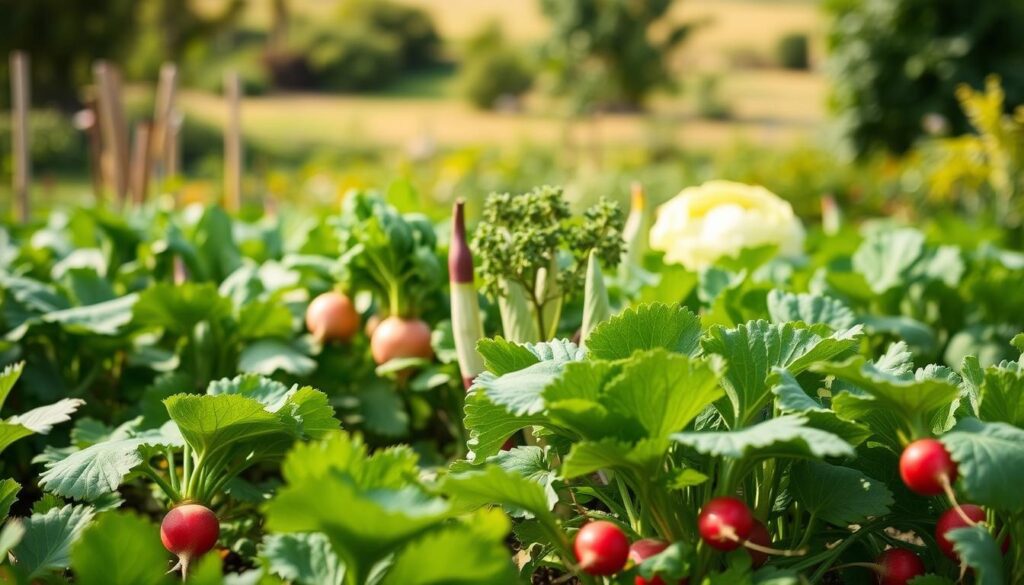
How to Plan Your Companion Planting Layout
Effective planning of your companion planting layout can lead to a thriving garden. When you design your garden, consider the unique needs of each plant, especially with radishes. Crafting a radish companion planting design involves more than just choosing plants that grow well together; it requires thoughtful organization of sunlight and space.
Using Companion Planting Principles
Companion planting principles suggest grouping plants that benefit each other. This strategy optimizes growth potential, allowing for better air circulation and reduced risk of pests. For example, pairing radishes with compatible companions can enhance flavor and growth. Consider planting taller plants nearby to provide necessary shade without obstructing sunlight entirely.
Planning for Space and Sunlight
Radishes thrive with at least six hours of sunlight daily, making it crucial to plan a layout that maximizes their exposure. When mapping out your garden, be mindful of taller plants that may cast shadows over your radishes. A well-thought-out planning companion planting layout will utilize vertical space effectively, allowing you to grow a diverse array of plants while ensuring that radishes receive the sunlight they need for robust root development.

Timing Your Planting for Success
Successful gardening relies heavily on understanding the right timings for planting various crops, particularly radishes. These root vegetables thrive in cooler temperatures, making their timing crucial. To achieve a successful radish planting timeline, aim to plant radishes about 45 to 60 days before the last frost date in spring or 45 to 60 days before the first frost date in fall. Knowing your local frost dates allows you to plan accurately, providing your radishes with optimal growing conditions.
Effective crop rotation strategies play a significant role in maintaining soil health and encouraging robust plant growth. Rotating crops each season helps prevent nutrient depletion and minimizes pest issues. Radishes are versatile and can fit seamlessly into various crop rotation schedules. By incorporating them wisely, you create a healthy environment for your garden that supports the growth of all your plants.
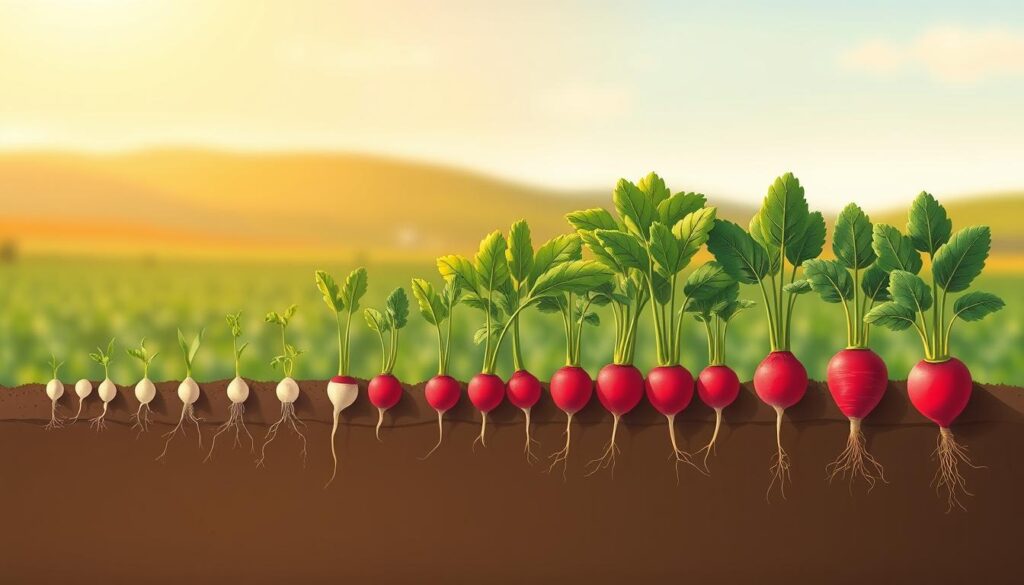
Maintaining a Healthy Garden Environment
Creating a thriving garden environment for radishes and their companion plants relies heavily on two essential elements: soil health and proper watering techniques. Ensuring these aspects are in balance will promote robust growth and abundant yields.
Soil Health for Companions
Healthy soil is the foundation of any successful garden. For radishes, you should conduct regular soil tests to evaluate pH and nutrient levels. This process helps identify if amendments are necessary for optimal conditions. An ideal soil mix for radishes should be rich in organic matter and well-draining to support root development.
Watering Techniques for Companion Plants
Consistent moisture is crucial, especially during the early stages of growth. Radishes thrive in humid conditions, so understanding proper watering techniques for companion planting is vital. Techniques such as drip irrigation or soaker hoses can provide steady moisture while minimizing water loss through evaporation. Mulching around plants can help retain soil moisture and suppress weeds, enhancing the overall health of your garden.
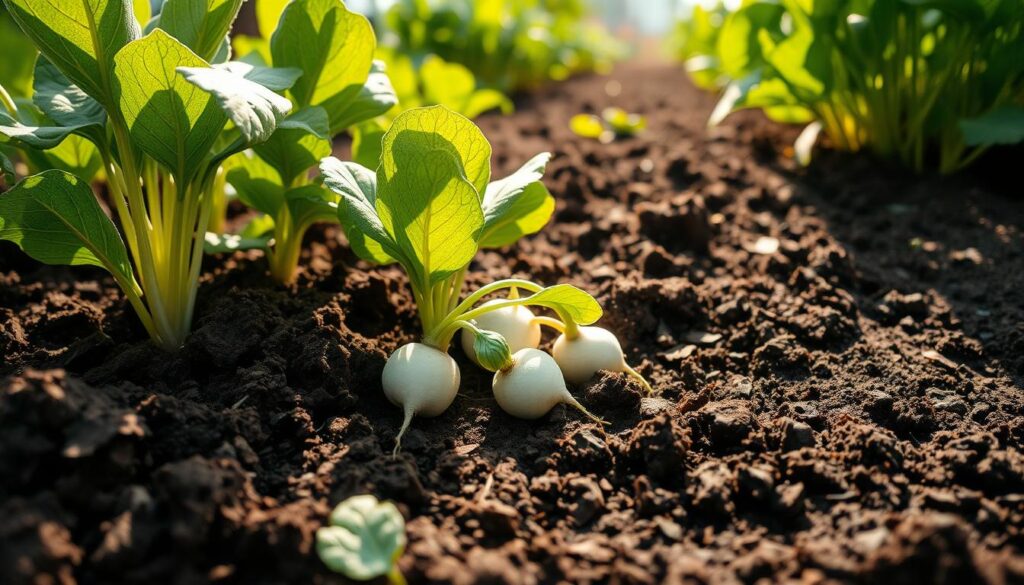
Recognizing Pests and Diseases
As you dive into radish gardening, staying vigilant about pests affecting radishes plays a crucial role in keeping your harvest healthy. Common threats include flea beetles and aphids, notorious for damaging leaves and stunting growth. This section will help you identify these pests, along with providing you with some effective natural pest deterrents for radish gardening.
Common Radish Pests
Flea beetles are small, jumping insects that can quickly cause significant harm to your radish plants. These pests typically create tiny holes in the leaves, leading to reduced photosynthesis. Aphids, on the other hand, cluster on leaves and stems, sucking sap and often transmitting diseases. Early detection of these pests is essential for successful management.
Natural Ways to Deter Garden Pests
Utilizing natural pest deterrents for radish gardening can effectively minimize the impact of harmful insects. Here are several strategies to consider:
- Introduce companion plants such as alliums. Their strong scent repels many pests.
- Plant marigolds nearby. These flowers deter aphids and other harmful insects.
- Regularly inspect your plants for early signs of infestations.
- Implement row covers to physically block pests from reaching your radishes.
By enhancing your garden with these natural pest deterrents for radish gardening, you can create a thriving environment that supports healthy plant growth.
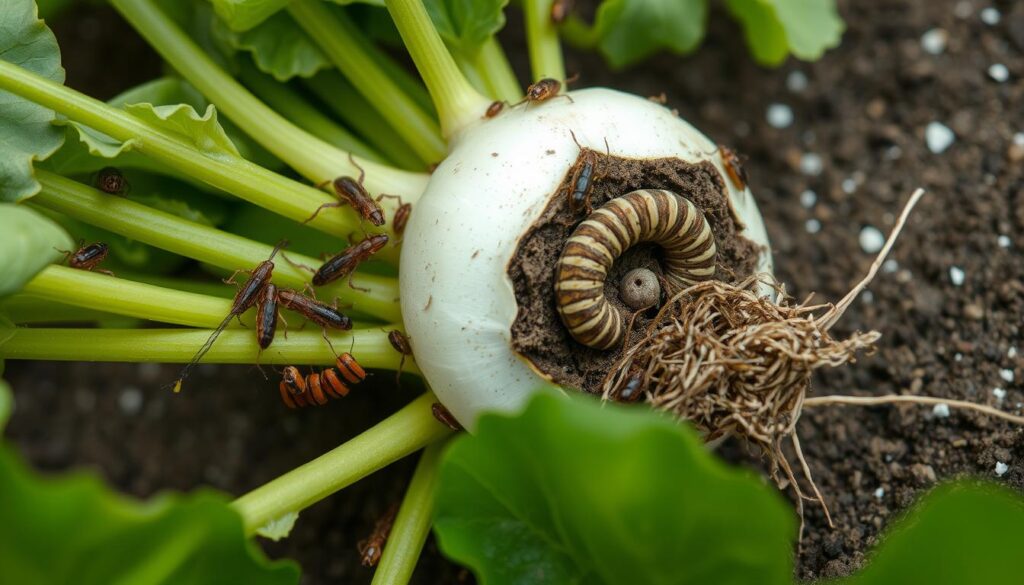
| Pest | Damage Type | Natural Deterrent |
|---|---|---|
| Flea Beetles | Holes in leaves | Alliums |
| Aphids | Sap-sucking, stunted growth | Marigolds |
| Root Maggots | Underground damage to roots | Companion planting with mint |
| Cabbage Worms | Leaf damage, holes in foliage | Neem oil treatment |
Integrating Radishes into Crop Rotation
Implementing a radish crop rotation strategy contributes significantly to garden productivity. Understanding the benefits of rotating radish crops can lead to healthier plants, improved soil quality, and reduced pest problems. Crop rotation helps manage soil fertility by ensuring that different nutrients are replenished through varied plant families, while also disrupting the cycles of pests and diseases that thrive in static environments.
Benefits of Crop Rotation
A successful rotation plan not only nourishes the soil but also offers various advantages. Among the most significant benefits are:
- Enhanced soil health: Rotating radishes helps maintain nutrient balance, particularly nitrogen, which is crucial for healthy growth.
- Pest control: Displacing radishes with different crops reduces the likelihood of pests establishing themselves in your garden.
- Fewer diseases: Avoiding repetitive planting in the same spot minimizes soil-borne diseases linked with radishes.
How to Rotate Your Radish Crops Effectively
To maximize the benefits of rotating radish crops, you should consider an effective plan. Follow these key steps:
- Plan your crop rotation: Develop a rotation plan that allows you to plant radishes only once every three years in the same area.
- Diverse crop selection: Choose a mix of crops to rotate with radishes, such as legumes, brassicas, and leafy greens.
- Monitor soil conditions: Regularly assess your soil nutrient levels to ensure that they remain balanced across different plant types.
By embracing a strategic radish crop rotation strategy, your garden stands to benefit both in productivity and sustainability. Maintaining healthy soil and managing pests becomes a natural part of your gardening routine.
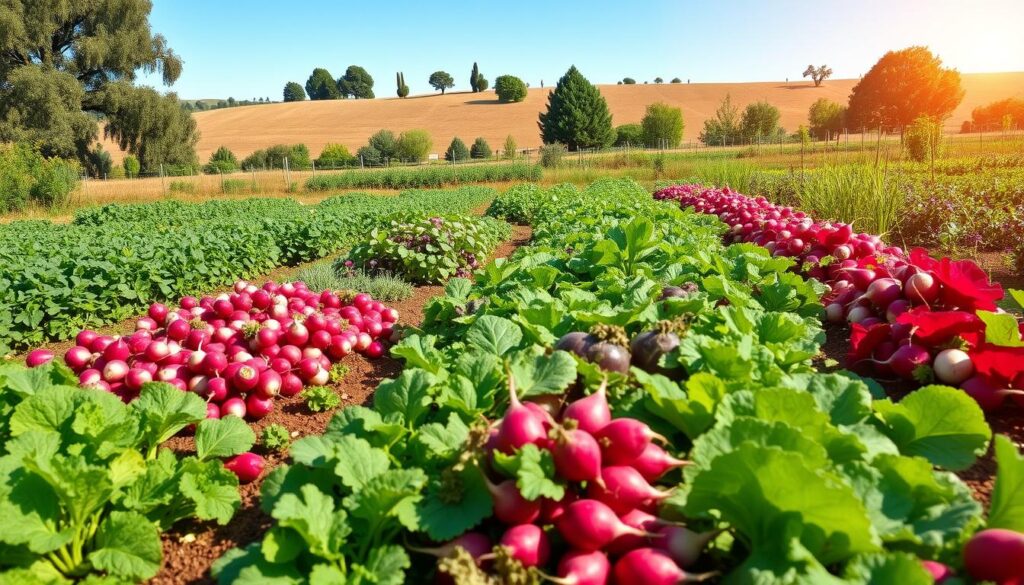
Harvesting Your Radishes
Timely harvesting plays a crucial role in enjoying the full flavors of radishes. Knowing the right moment to pull them from the soil ensures optimal taste and texture. Here’s how to determine when to harvest and the best practices to follow.
Knowing When to Harvest
Radishes typically reach maturity about 25 to 30 days after planting. Look for signs such as size and firmness to decide if they are ready. Underestimating their growth might lead to small, less flavorful roots, while letting them grow too long can result in a woody texture. Keeping an eye on their development will help you learn how to harvest radishes effectively.
Best Practices for Harvesting
When ready, gently pull radishes from the soil to minimize damage. Utilize radish harvesting techniques like loosening the surrounding soil with a garden fork before extraction. This method helps disengage the roots from compacted soil, reducing the risk of breaking their delicate tops. Always aim for a careful approach, ensuring a smooth and successful harvesting experience.
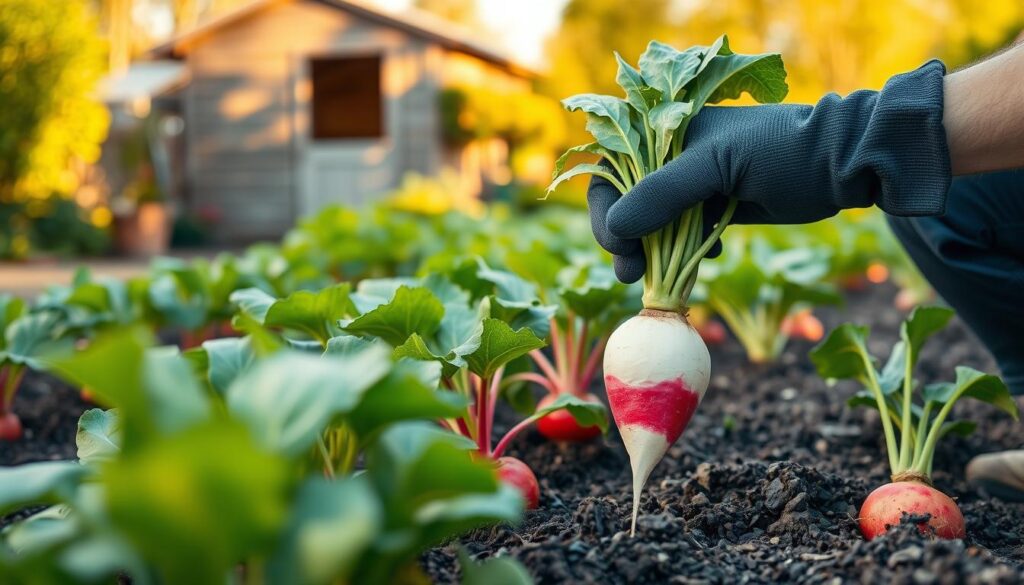
Recipes and Ideas for Using Radishes
Radishes are a versatile vegetable that can elevate your culinary creations. Their crisp texture and peppery flavor make them perfect for a variety of dishes. Whether you’re looking for a refreshing salad or a creative side, incorporating radishes into your meals can enhance both taste and nutrition.
Creative Ways to Enjoy Radishes
Radish recipes offer an exciting range of options. You can enjoy them raw for a crunchy snack or add them to a stir-fry for a dash of color and flavor. Pickled radishes are another fantastic option, bringing brightness to sandwiches and tacos. For a more unique dish, consider roasting radishes; this method mellows their spice and transforms them into a sweet, caramelized delight.
How to Use Radishes in Salads
Using radishes in salads introduces an exciting bite to your greens. Try combining thinly sliced radishes with arugula, cherry tomatoes, and feta cheese for a vibrant salad. You can also mix them with cucumbers for a refreshing side, drizzled with a lemon vinaigrette for added zing. Don’t shy away from experimenting with ingredients — nuts, seeds, or herbs can further elevate your dish. Embrace these radish recipes to keep your salads both nutritious and delicious.
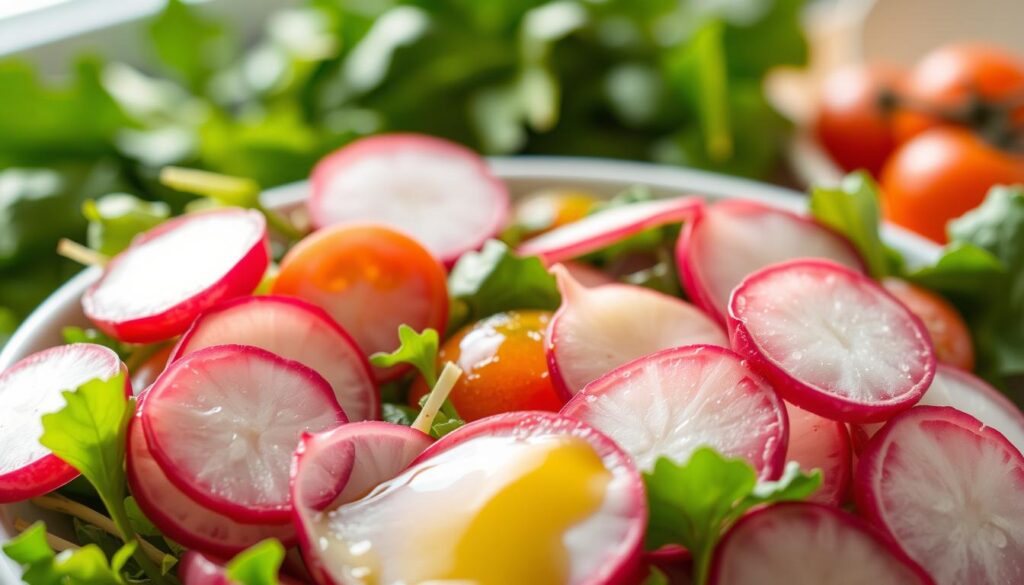
Learning from Other Gardeners
Engaging with other gardeners can greatly enrich your knowledge about companion planting. By exchanging ideas and insights within the gardening community, you open the door to a wealth of knowledge that can enhance your gardening journey. Each gardener brings unique experiences and perspectives, fostering a vibrant atmosphere for learning and exploration.
Sharing Experiences with Companion Planting
One of the most valuable aspects of gardening is the ability to share your experiences. Discussing what has worked well and what hasn’t can help others in their own gardening efforts. Whether you’re part of a local gardening club or connect through online forums, these conversations can spark innovative ideas for your own garden. You might discover new plant pairings or methods that improve your companion planting strategies. Engaging in dialogues about successes and challenges cultivates a supportive environment for all gardeners.
Building a Gardening Community
Creating connections within the gardening community fosters camaraderie and support. You can benefit from collective knowledge, learn from others’ trials, and even form friendships based on a shared passion for gardening. These relationships can evolve into a network where you can ask questions, share tips, and motivate one another. In turn, this nurturing environment enhances your gardening skills and makes the process more enjoyable for everyone involved.
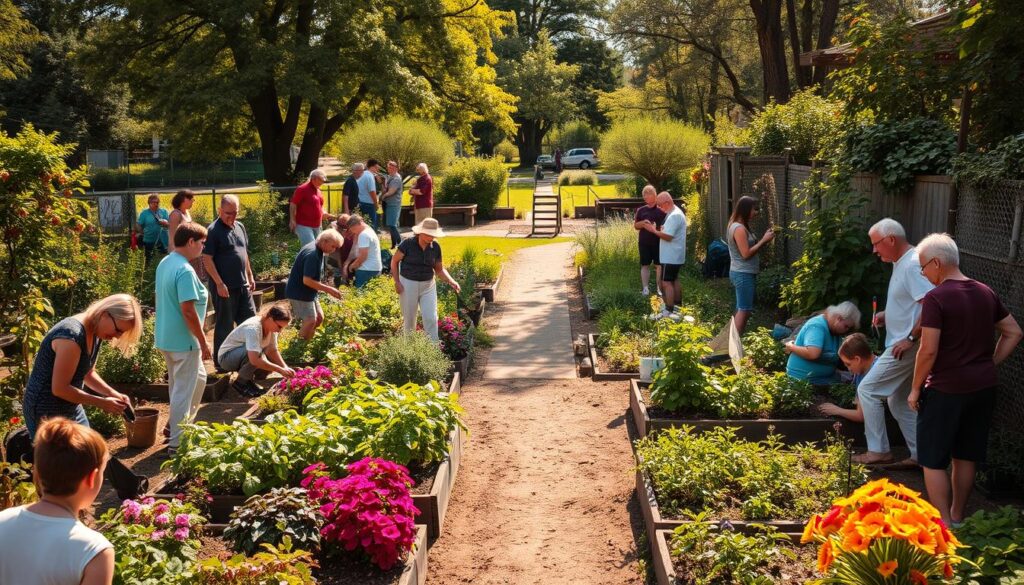
Conclusion: Elevate Your Garden with Radishes
As you wrap up your exploration of enhancing your garden with radishes, it’s essential to reflect on the key strategies discussed. Utilizing companion planting not only boosts the growth of your radishes but also encourages the health and vitality of your entire garden ecosystem. By selecting the right partners for your radishes and nurturing their growth needs, you will create a vibrant and productive space.
Remember, maintaining optimal soil health and employing effective watering techniques are crucial components in achieving a bountiful harvest. Each step you take on your gardening journey will help you gain valuable insights and encourage your passion for gardening. Embrace the joys of cultivating your garden and savor the satisfaction that comes with each successful planting season.
In summary, as you cultivate your garden with radishes and their companions, you foster not just a productive environment but also a rewarding experience. Keep exploring, experimenting, and learning, and soon enough, you’ll reap the benefits of your hard work while inspiring others to join in this wonderful, encouraging gardening journey.
